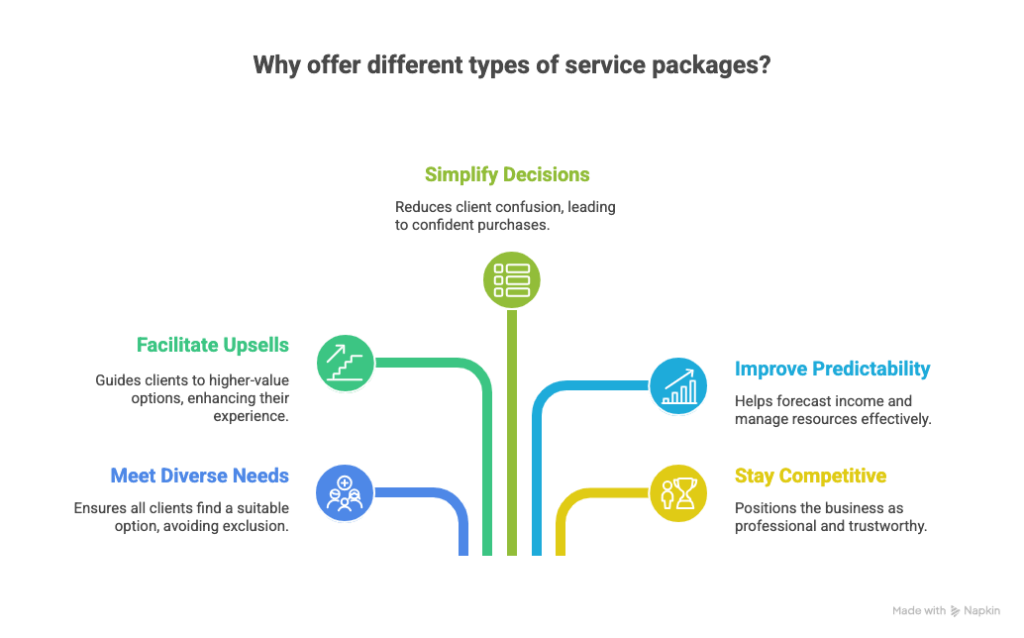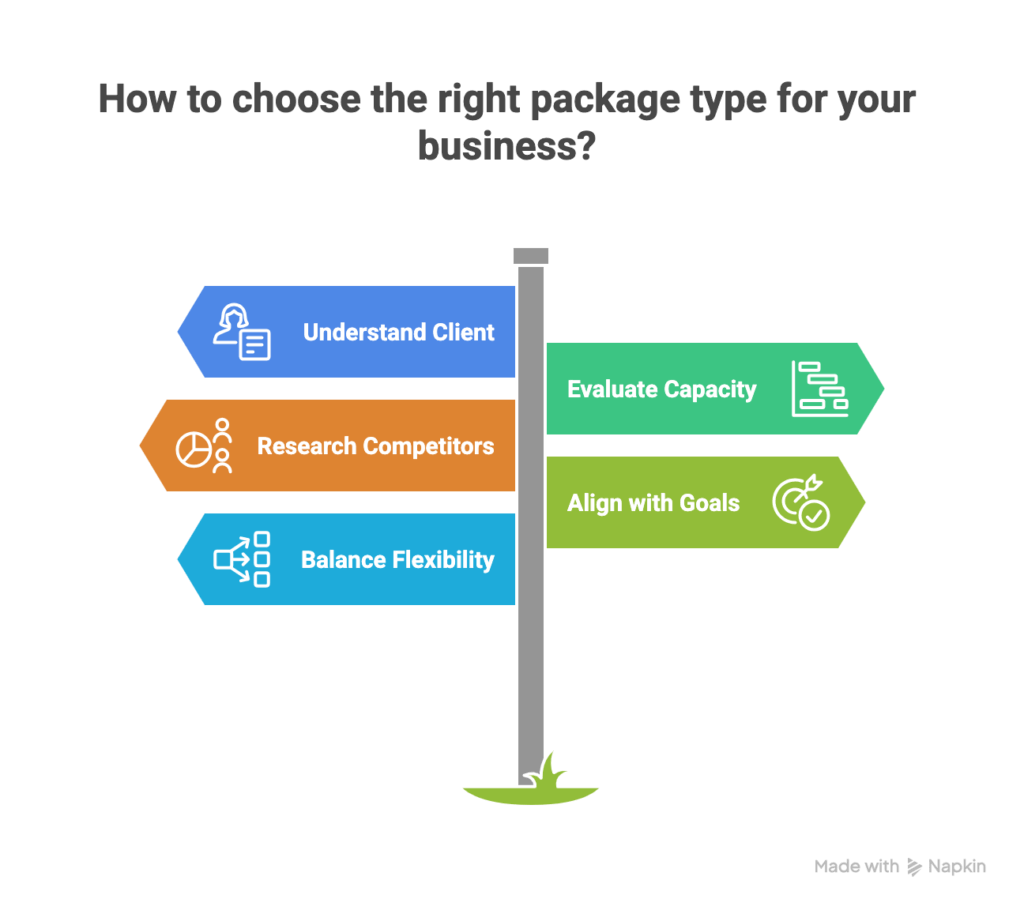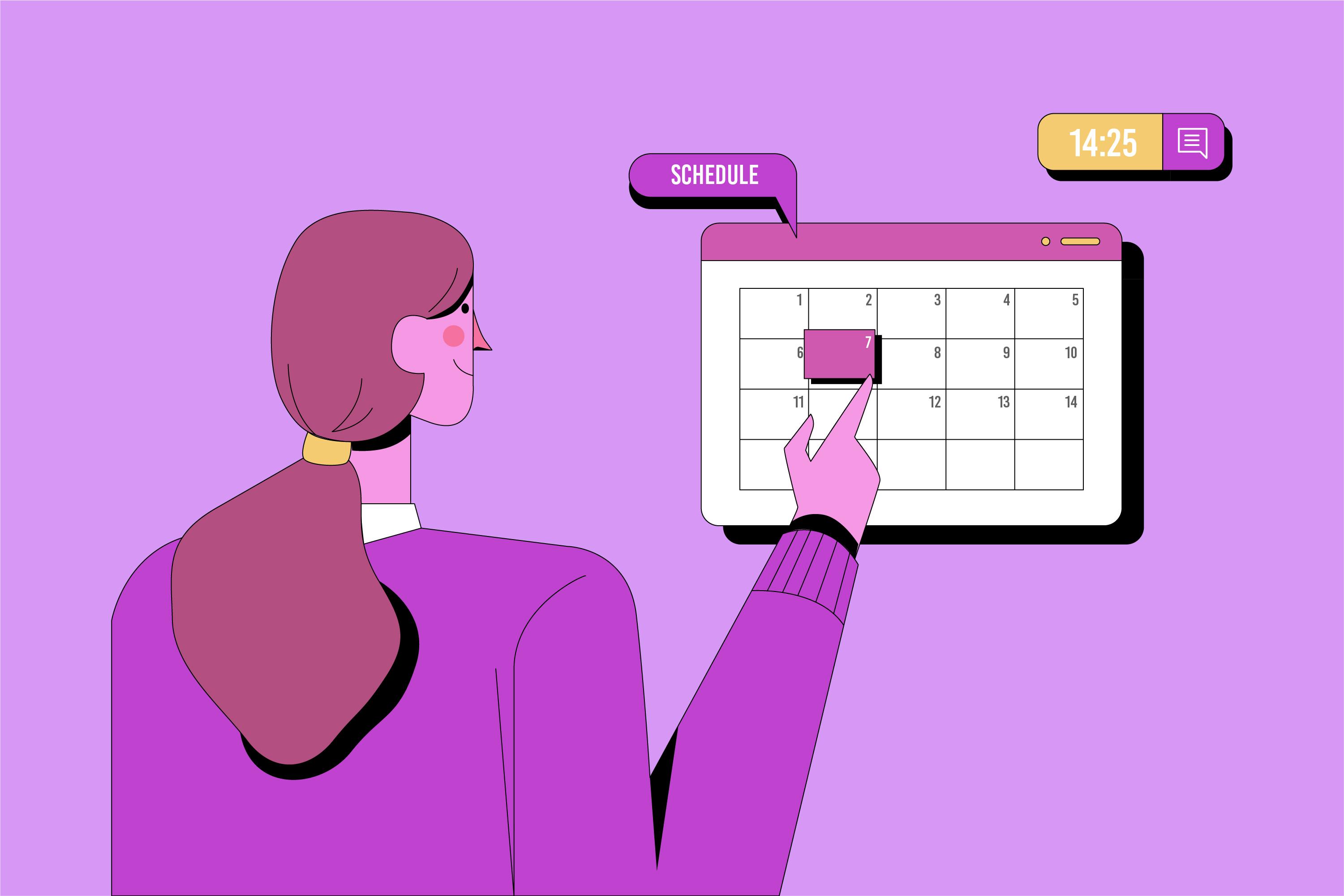When it comes to running a service business, how you present and package your offerings can make all the difference. It’s not just grouping services together, service packages are there to create structure, simplify decision making for clients, and highlight the value of what you offer.
But if you do it wrong, you risk more than just confusion. You may end up undercharging for high-value work, losing upsell opportunities, or overwhelming potential customers with too many unclear choices.
Let’s see how to make the best of service packages, what types exist, how each one works, and how to choose the right model for your business!
Why Different Types of Service Packages Matter
Not all clients have the same needs, budgets, or expectations, and that’s exactly why offering different types of services matters. If you structure your services in multiple ways, you create flexibility for clients and clarity for the business.
#1 Meeting diverse client needs
Each client comes with unique goals and resources. Offering multiple package types, like basic, premium or custom options, ensure that every client can afford something that fits their needs without feeling excluded or pressured.
#2 Facilitating upsells and upgrades
Tiered or add-on packages make it easier to guide clients toward high-value options. When customers clearly see the added benefits of an upgraded package they're more likely to invest in a better experience.
#3 Simplifying purchasing decisions for clients
Well-structured packages reduce friction in the buying process. Instead of comparing endless service details, clients can quickly understand what’s included at each level and make confident decisions.
#4 Improving predictability and revenue
Defined packages make it easier to forecast income, manage resources, and maintain consistent service delivery. They help you standardize pricing and reduce the uncertainty that often comes with custom quotes.
#5 Staying competitive
Nowadays clients expect transparent pricing and clear options. Offering a variety of packages positions your business as professional, trustworthy, and easy to work with - giving you an edge over competitors who still rely on vague or ad-hoc pricing.
Core Types of Service Packages
Standard/Predefined packages
Standard or predefined packages are fixed offerings that include a specific set of services for a set price. Clients know exactly what they’re getting and how much it will cost upfronts, no surprises or negotiations.
How they work:
These packages are ideal for services that follow a predictable structure, like beauty treatments, coaching sessions, photography shoots, or maintenance visits. You simply define what’s included, how long it takes, and set a fixed price.
They’re simple, clear and easy to understand. Predefined packages help streamline your booking process and reduce back-and-forth communication since everything is already outlined.
TIps:
- Clearly define the scope, what’s included and what’s not, to avoid misunderstandings
- Consider offering two or three tiers to accommodate different budgets and expectations.
- Use clear, descriptive names that reflect the value of each package.
Customized/Bespoke packages
Customized or bespoke packages are tailor-made solutions created to fit each client’s specific needs. Instead of a fixed list of services, you collaborate with the client to design a package that matches their exact goals, timeline, and budget.
Why they’re valuable:
These packages offer maximum flexibility and personalization, something many clients are willing to pay more for. They’re built around unique requirements, you can often charge higher rates, strengthen client relationships, and deliver more meaningful results.
The biggest challenge of this type of package is keeping projects under control, since clients often add new requests that weren’t included in the original plan.
Tips:
- Define the project scope clearly from the start
- Set firm boundaries, anything outside the agreed scope should trigger a new quote or “change order”
- Factor in extra time for communication and adjustments when pricing
Tiered packages
How they work:
Tiered packages offer your services at different levels, usually labeled as Basic, Standard, and Premium. Each one includes a different amount of value, giving clients flexibility to choose what best fits their needs and budget.
This model makes it easy for clients to compare options and pick what feels right for them. It also helps guide customers toward higher-value packages by clearly showing benefits of upgrading.
Tips:
- Make sure each tier adds real, noticeable value compared to the one before it
- Keep the price difference logical, each step up should feel worth the extra cost
- Highlight the most popular or best-value option to make the decision easier for clients
Subscription/recurring packages
How they work:
Subscription packages let clients pay a recurring fee monthly, quarterly, or annually, for ongoing access to your services. Instead of booking each time, clients stay subscribed.
These packages provide predictable income and help you build long-term client relationships. They also make things easier for clients since they don’t have to rebook every time, they simply enjoy consistent service.
Challenges:
The main challenge is keeping clients engaged over time. If they stop seeing the value in your service, they may cancel subscriptions, so it’s important to continually prove that your work delivers results or ongoing benefits.
Tips:
- Offer clear commitment periods, like 3 or 6 months, to sex expectations
- Make it easy for clients to upgrade or downgrade their plans as their needs change
- Send regular updates or reports that remind clients of the value they’re getting
- Add small perks or bonuses for loyal subscribers to improve retention
Value-based packages
Value-based packages are priced according to the results or outcomes you deliver, not the time or effort you spend. Instead of charging by hour or per task, you set price based on the value your service creates for the client.
Why use them:
This approach aligns your success with your client’s success. When clients see that your service directly helps them achieve measurable results, they’re often willing to pay more.
Challenges:
The tricky part is estimating and justifying the value of your work. You’ll need to clearly define what success looks like and agree on how it will be measured. There’s also some risk involved if results depend on factors outside your control.
Tips:
- Clearly define the outcome or the goal your service aims to achieve
- Use data, case studies, or testimonials to show the value you’ve provided before
- Explain the potential ROI in simple terms
- Set measurable metrics so both you and the client can track results
Add-on/supplemental packages
Add-on or supplemental packages include extra services or features that clients can add to their main package. They’re optional upgrades that give clients the chance to customize their experience without changing the core offer.
Why use them:
Add-ons are a great way to increase your average order value while giving clients more flexibility. They let customers build their ideal package, choosing only the extras that matter most to them. This is a great way to upsell your services.
Challenges:
Offering too many add-ons can overwhelm clients or make pricing structure confusing. If not presented clearly, customers might skip them altogether or feel unsure what’s worth adding.
Tips:
- Keep your list of add-ons short and directly related to your main service
- Use clear descriptions and transparent pricing
- Present add-ons during checkout or booking, where they feel like natural upgrades
- Highlight the benefits of each add-on so clients their value
Hybrid packages/combo models
Hybrid packages combine two or more types of service models, for example a subscription plan with optional add-ons, or a standard package that includes some customizable elements. This approach allows you to balance structure with flexibility, giving clients more control over what they get.
Benefits:
If you blend different models, you can appeal to a wider range of clients. Some may prefer fixed pricing, while others want personalization or recurring support. Hybrid packages let you offer both, which can increase satisfaction and revenue potential.
Challenges:
Hybrid packages have moving parts, so you need to carefully plan them and communicate clearly with your clients. If the boundaries between fixed and customizable parts aren’t clear, clients might misunderstand what’s included or expect more than what's agreed on.
Tips:
- Clearly define which parts of the package are fixed and which can be adjusted
- Keep the structure simple enough for clients to understand at a glance
- Use clear tier names or visual breakdowns to show how each component fits together
- Review and update hybrid offers regularly to keep them balanced and profitable
Trafft: Your Best Partner for Service Packages

Want one less worry about your business? That’s where Trafft steps in!
Trafft is an all-in-one booking system that streamlines your entire service process - from managing appointments and payments to organizing your team and tracking client activity.
Key Trafft features that will help you boost your business
Customizable packages: Create and tailor service packages that fit perfectly your clients’ needs. With Trafft, you can combine different services, set flexible pricing and offer exclusive deals, all from one simple dashboard.
Flexible scheduling: Let clients book multiple appointments in a single step, saving time and making the booking experience smoother. Ideal for ongoing or multi-session services, like coaching, fitness, or beauty treatments.
Automated reminders: Cut down on no-shows with automatic email and SMS reminders. Trafft keeps clients informed about their upcoming appointments, so you can stay organized and focus on delivering great service.
Seamless integration: Connect Trafft with various payment gateways and calendar tools to create a frictionless booking and payment experience, both for you and your clients.
User friendly interface: Trafft’s clean and intuitive design makes it easy for both businesses and clients to navigate. Managing appointments, tracking packages, and making updates in just a few clicks.
With Trafft’s smart scheduling and powerful package management tools, you can effortlessly design, sell, and manage service packages that boost client satisfaction and drive consistent business growth!
How to Choose the Right Package Type for Your Business
With so many service structures, you should choose the types that fit your business model and client base. Here’s how to make the right choice:
Understand your client
Start by identifying your main client segments, like their goals, budgets and preferences. Some clients want flexibility and customization, while others prefer ready-made options that are simple to book.
Evaluate your capacity and strengths
Think about how much time and resources you can dedicate to each client. If your workflow is tight, standardized or tiered packages can be a good choice. If you have more room for personalization, consider custom or hybrid models.
Look at your industry and competitors
Research what’s common in your business’s niche. If you know what your competitors offer, you can spot opportunities to stand out, whether through pricing, added value, or a unique package format.
Align with your business goals
Decide what’s your main goal, and what you want to achieve: steady recurring revenue, high-value one-time projects, or a mix of both. Your goals determine whether subscriptions, predefined packages, or value-based pricing work best.
Balance structure and flexibility
Too rigid, and you may lose clients who want customization. Too flexible, and you’ll spend too much time adjusting offers. Aim for balance that gives clarity to clients while protecting your time and margins.
Test and refine
Launch a few package types, track how they perform, and adjust based on client feedback and sales data.
Monitor key metrics
Watch which packages sell the most, which bring the highest profit, and where clients drop off or churn. Use this data to continuously improve your offers and pricing strategy.
Closing Thoughts
Well-structured packages will help you communicate your worth clearly, simplify booking decisions, and open the door to steady, predictable revenue.
When designing the packages, the key is to make them around your clients’ needs while keeping your operations efficient. Start small, test what works, and refine your approach as you learn more about what your audience values most.
Trafft can help you turn those ideas into action. Start creating your own service packages with Trafft today, and watch your business grow with every booking!








